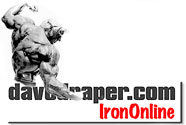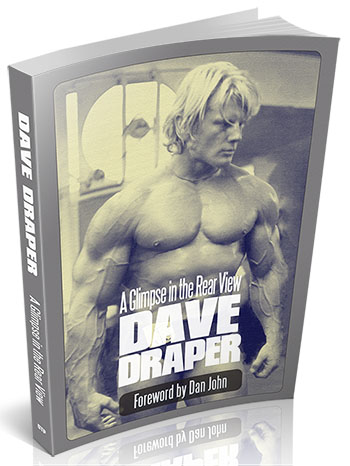Learn From My Mistakes

Download the full Draper here newsletter
in printable, live-link, pdf format, here.
A dozen years ago I did an interesting interview on a site that’s since gone dark. People liked the interview, and since it’s been an uneventful week with nothing outstanding to write about, let’s have a re-do.
1. What do you feel is the single greatest trait that led to your success in bodybuilding, and why?
Nothing I possessed in the way of structure or body chemistry was outstanding. A six-foot frame with a large bone structure is certainly an advantage for which I’m thankful, but they didn’t separate me from the crowd. Further, I didn’t have a burning ambition or dream to become a champion, a nuclear scientist or the President. I did in the early years have a simplistic approach on all projects undertaken… still do. What do I want? Is it sensible and worthwhile, and how do I -- with common sense -- accomplish it? Once the questions are answered (guesses count), do it. Here you have a goal, focus and commitment.
It’s during the simple process of achieving that one develops those grand habits and character qualities more valuable than blue chips or chocolate chips. Determination is one competent ally in gaining anything we have positioned before us. And determination spawns discipline, the thick leather reins that prompt and lead the untamable animal. The sum of determination and discipline is perseverance, the impenetrable armor of warriors.
Keep your eye on that worthy goal; choose the logical (simple, most basic) way to go, and go. Go hard. It’s a struggle, yet without intensity, I’ve discovered I don’t go far. Make room in your heart and mind to gather and store the determination, discipline and perseverance found in thick clumps along the way.
Patience follows like a tired old mare; get used to her.
2. When training with weights, beginners often struggle to find the exercises and techniques that work best for their body types. What exercises and routines seemed to work best for you when you were starting out? And what exercises did you try to avoid?
When I was starting out, I was very young and made up some dumb rules as I went along. Once I got my hands on some battered wall charts demonstrating the variety of exercises one could do, I chose the simplest (coincidentally like my own favorite inventions) and continued to train, grow in understanding and gain in muscle development. I was 12, what else could I do? What more could I expect?
The biggies that kept me going, growing and interested were standing barbell curls, wrist curls, lying and standing triceps extensions or presses, bench presses, bentover barbell rows and stiffarm pullovers. I, like most kids, ignored the legs, as if they were miles away, below the beltline and out of sight.
Note: When I refer to barbell, I speak of a 16-inch bar with my limited selection of weights in the center and my tightfisted mitts squeezing what little was left of the bar’s short ends. The volume varied from 1 to 20 sets and reps, as I intuitively sorted things out and eventually added to my equipment list. Any routine worked as long as I stuck to it with regularity for 30 minutes. The idea of technique is not applicable to whatever it was I did during those grimacing, premature workouts. Wrestling, free-for-all and slugfest more appropriately describe the action taking place… a brawl or a battle-royale.
What I tried to avoid was dropping that congested bar on my head. Though I had no supervision early on, I was reasonably safe because I didn’t have very much poundage. The meanest wrong one can do when new to weight training is to use too much iron with too little know-how and too little physical conditioning.
Common disaster: “This is fun. I wonder how much weight can I bench press?”
Tendons and muscle insertions that are unprepared for heavy resistance might tear or otherwise be damaged when subject to exuberant and heavy lifting: painful, frightening, disappointing and perhaps chronic.
Later, though, as I stepped into the VMCA and Vic Tanny’s of the late ’50s, I zipped forward to dumbbells of assorted sizes, benches, racks and cables. Supersetting with the basic movements became my thing then, and is to this day. Added to the list of original exercises I practiced as a kid are squats and deadlifts and shrugs and pulldowns and dumbbell presses… nothing fancy, just solid.
3. Many people who begin weight training are looking to build mass in their arms and chest. Can you talk about the importance of symmetry to a physique?
It’s important to understand the necessity of seeking balance in developing muscle structure. The body works as a system, mutually supporting and interdependent, and performs more healthfully and efficiently when developed as a functioning whole. Muscles grow faster, overall conditioning is achieved and no part of the body lags behind in formation as a result of neglect.
Imbalance in strength and structural development can cause chronic pain and degrees of disability as the years go by. For example, a predominantly strong arm and chest development can lead to shoulder-rotation troubles; an abdominals muscle deficiency can lead to lower back troubles; weak hamstrings can present knee problems. Does one want pain and limitations?
Getting huge at all cost is not unheard of among budding bodybuilders of all ages. Why not? They are promised extraordinary gains in short periods of time, if they use this formulation or that stack while following a champ’s routine. Stop and think. It’s smart to consider from the onset the eventual appearance of the body -- body esthetics, beauty, balance and appeal -- when enthusiastically embracing the bodybuilding field. A lopsided body can be a problem to correct, reflects your thinking and follows you wherever you go.
Simultaneously, however, I believe anyone who begins to train with weights should do whatever he or she feels like doing for whatever purpose. You can usually get away with a few months of floundering and butting your head against the wall without knocking your brains out or building 19-inch arms on a 150-pound frame. Gives the would-be champ time and space to search, invent, express, improvise and make a bunch of instructive mistakes of his very own. Freedom before margins.
4. Are there any nutritional secrets that beginners need to know to develop a powerful, healthy physique?
There are no secrets. Train hard, eat right and be happy!
Nutrition counts -- big time. What you eat is what you get. Eat regularly to fuel and restore the muscles throughout the day, once every three to four hours is my habit. Up your intake of muscle-building protein (red meat, fish, poultry, dairy products, some nuts). Exclude or greatly minimize simple sugars in your menu. Eat lots of fresh vegetables and a fair share of fresh fruit (watch the sugar); get your fiber and eat whole-grain breads and grains that have not been overly processed.
Don’t eat junk food, fast food and don’t overeat. Without drowning yourself, drink jugs of water. Take a dose of essential fatty acids (EFAs) daily, and a protein powder to supplement meal planning if eating consistently is a problem -- or to help gain weight, or as a most important pre-workout and post-workout fortifier.
Simple, basic, honest. Takes devotion and habit building. It works, that’s all. It works.
Turns out this interview was a long one. Let’s finish this next week.
dd
*****
You don’t have to sign up for Facebook to read Dave’s commentary and interactions on his Facebook page. Dave is on Facebook here:
http://www.facebook.com/bodybuilderdavedraper
Dave is on Twitter, here:
---
Take a trip over to our
Musclebuilding Q&A Blog
... where Dave allows us a peek into his email outbox.
Did you sign up for Dave's expanded email yet?
It's free, motivating and priceless!
We'll also send you a link to Dave's free
Body Revival Tips and Hints e-report with your confirmation notice.

